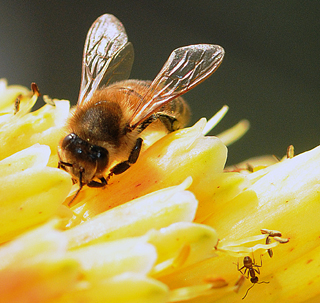Bees are more genetically related to ants than they are to social wasps such as yellow jackets and paper wasps, according to a new paper.
Ants, bees and stinging wasps all belong to the aculeate (stinging) Hymenoptera clade, the insect group in which social behavior is most extensively developed, said senior author and ant specialist Phil Ward, professor of entomology at UC Davis.
The use of genome sequencing and bioinformatics answers a piece of a long-standing, unanswered evolutionary puzzle. Previously it was thought that ants and bees were distantly related, with ants being closer to certain parasitoid wasps.
The scientists combined data from the transcriptome — showing which genes are active and being transcribed from DNA into RNA — and genomic (DNA) data from a number of species of ants, bees and wasps, including bradynobaenid wasps, a cuckoo wasp, a spider wasp, a scoliid wasp, a mud dauber wasp, a tiphiid wasp, a paper wasp and a pollen wasp; a velvet ant (wasp); a dracula ant; and a sweat bee, Lasioglossum albipes.

A bee and an ant hanging out. Credit: UC Davis
Of particular interest was the finding that ants are a sister group to the Apoidea, a major group within Hymenoptera that includes bees and sphecid wasps (a family of wasps that includes digger wasps and mud daubers).
“This result should be important for future studies focused on eusocial evolution, as it suggests that morphology may not be a good indicator of evolutionary relatedness in these groups of organisms,” said lthe lead author, UC Davis Assistant Professor Brian Johnson.
Eusocial behavior is characterized by cooperative brood care, overlapping adult generations and division of labor.
The results also provide a new perspective on lower Cretaceous fossil Cariridris bipetiolata, originally claimed to be the oldest fossil ant. Scientists later reinterpreted it to be a spheciform wasp.
“Our discovery that ants and apoids are sister taxa helps to explain difficulty in the placement of Cariridris,” the authors wrote in the paper, “and suggests that it is best treated as a lineage close to the root of the ant-apoid tree, perhaps not assignable with certainty to either branch.”
The scientists discovered that the ancestral aculeate wasp was likely an ectoparasitoid, which attacks and paralyzes a host insect and leaves its offspring nearby where they can attach to the outside of the host and feed from it.
CitationL Brian R. Johnson, Marek L. Borowiec, Joanna C. Chiu, Ernest K. Lee, Joel Atallah, Philip S. Ward, 'Phylogenomics Resolves Evolutionary Relationships among Ants, Bees, and Wasps', Current Biology October 3, 2013 DOI: 10.1016/j.cub.2013.08.050





Comments